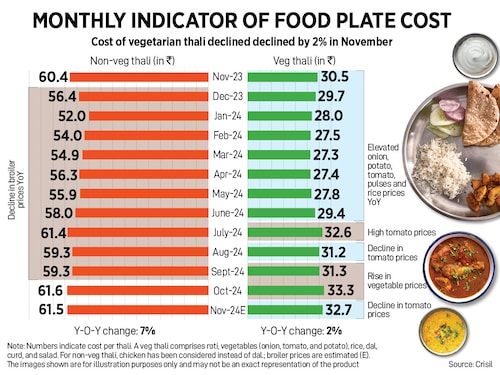How India Eats: Tomato, potato once again amp up thali prices in Nov
Potato prices increase as late blight infestation in Punjab, Uttar Pradesh and Gujarat reduces yield



Rising prices of tomato and potato continued to drive food costs higher in November. In addition to vegetables, an increase in the prices of pulses also contributed to the overall costs of food plates/thali.
The average price of a home-cooked vegetarian thali increased 7 percent to Rs 32.7 in November, shows a Crisil analysis. This compares to Rs 30.5 in the same month last year. The price of a vegetarian thali declined 2 percent, however, from Rs 33.3 in October. The vegetarian thali prices rose due to an increase in the prices of tomato and potato, which collectively account for 26 percent of the thali cost.
The prices of tomato jumped 35 percent year-on-year to Rs 53 per kg in November, compared to Rs 40 per kg. Tomato prices declined by 17 percent month-on-month in November with fresh supplies from Madhya Pradesh, Maharashtra and Gujarat in October. However, further price decline was arrested due to lower arrivals in November.
Potato prices rose 50 percent year-on-year to Rs 37 per kg in November from Rs 25 per kg last November. The increase in potato prices was due to a 20 percent year-on-year decline in arrivals in the month amid low yield due to late blight infestation in Punjab, Uttar Pradesh and Gujarat.
The prices of pulses also increased 10 percent year-on-year due to the lower opening and pipeline stocks. Prices are expected to dip from December onwards once fresh arrivals begin. Adding to the cost, vegetable oil prices rose 13 percent year-on-year due to the import duty hike coupled with the festive and wedding season demand.
Also read: How India Eats: Crop damage due to rains heats up thali cost in Oct
An 11 percent drop in fuel cost, from Rs 903 last year for a 14.2 kg LPG cylinder in Delhi to Rs 803 currently, prevented further increase in the thali cost, says Crisil.
For the non-vegetarian thali, an estimated decline of 3 percent year-on-year in broiler prices arrested overall cost. Broiler prices account for 50 percent of the non-veg thali cost. A non-vegetarian thali cost Rs 61.5 in November, rising 2 percent from year-ago period at Rs 60.4.

The average cost of a thali is calculated based on the input prices in north, south, east and west India. The data also reveals the ingredients (cereals, pulses, broiler poultry, vegetables, spices, edible oil, cooking gas) driving changes in the cost of a thali.
The monthly series "How India Eats" takes a look at how the average price of a food plate in India changes every month, indicating the impact on the common man"s expenditure, by analysing the Indian thali.
First Published: Dec 05, 2024, 16:41
Subscribe Now